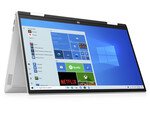HP Pavilion x360 15-er0155ng
Specifications

Primary Camera: 0.9 MPix
Price comparison
Average of 1 scores (from 2 reviews)
Reviews for the HP Pavilion x360 15-er0155ng
HP’s 2-in-1 device features the Core i5-1135G7, 16 GB of dual-channel RAM and an NVMe SSD. This is why it can handle all modern tasks. The touchscreen can be operated with the fingers or the HP Tilt Pen.
Source: Laptop Media
 Archive.org version
Archive.org versionThe question this year is should you buy a laptop for the sake of having a laptop, or you should make more conscious decisions. The chances are, since you are this far into the review, that you want to make a thoughtful purchase choice. And congratulations to you. Before saying our final opinion on this device, we would like to summarize what we learned. First, its battery life is right about 3.6 – not great, not terrible. It is a bit small with its 43Wh of capacity, and this is clearly reflected in the scores. We got 8 hours and 3 minutes of Web browsing, and 6 hours and 29 minutes of video playback. This is by far not the worst result we’ve seen, but it is definitely not among the best ones either. HP Pavilion x360 15 (15-er0000)’s touchscreen IPS panel (Innolux CMN1512) has a Full HD resolution, comfortable viewing angles, and a good contrast ratio. Thankfully, it doesn’t flicker at any brightness level. On the downside, it covers only 55% of the sRGB color gamut.
Single Review, online available, Very Long, Date: 10/20/2021
Source: Laptop Media
 Archive.org version
Archive.org versionSupport, online available, Short, Date: 10/20/2021
Comment
Intel Iris Xe G7 80EUs: Integrated graphics card in Intel Tiger Lake G7 SoCs based on the new Gen. 12 architecture with 80 EUs (Execution Units / Shader Cluster). The clock rate depends on the processor model. The Tiger Lake chips are produced in the modern 10nm+ process at Intel.
Modern games should be playable with these graphics cards at low settings and resolutions. Casual gamers may be happy with these cards.
» Further information can be found in our Comparison of Mobile Graphics Cards and the corresponding Benchmark List.
i5-1135G7: A quad-core, mid-range processor of Tiger Lake product family designed for use in ultra-light laptops. The i5 is manufactured on Intel's second-gen 10 nm process marketed as SuperFin and features an 80 EU Iris Xe G7 iGPU. Core i5-1135G7 has a base clock speed of 2.4 GHz as long as it is allowed to consume 28 watts.» Further information can be found in our Comparison of Mobile Processsors.



